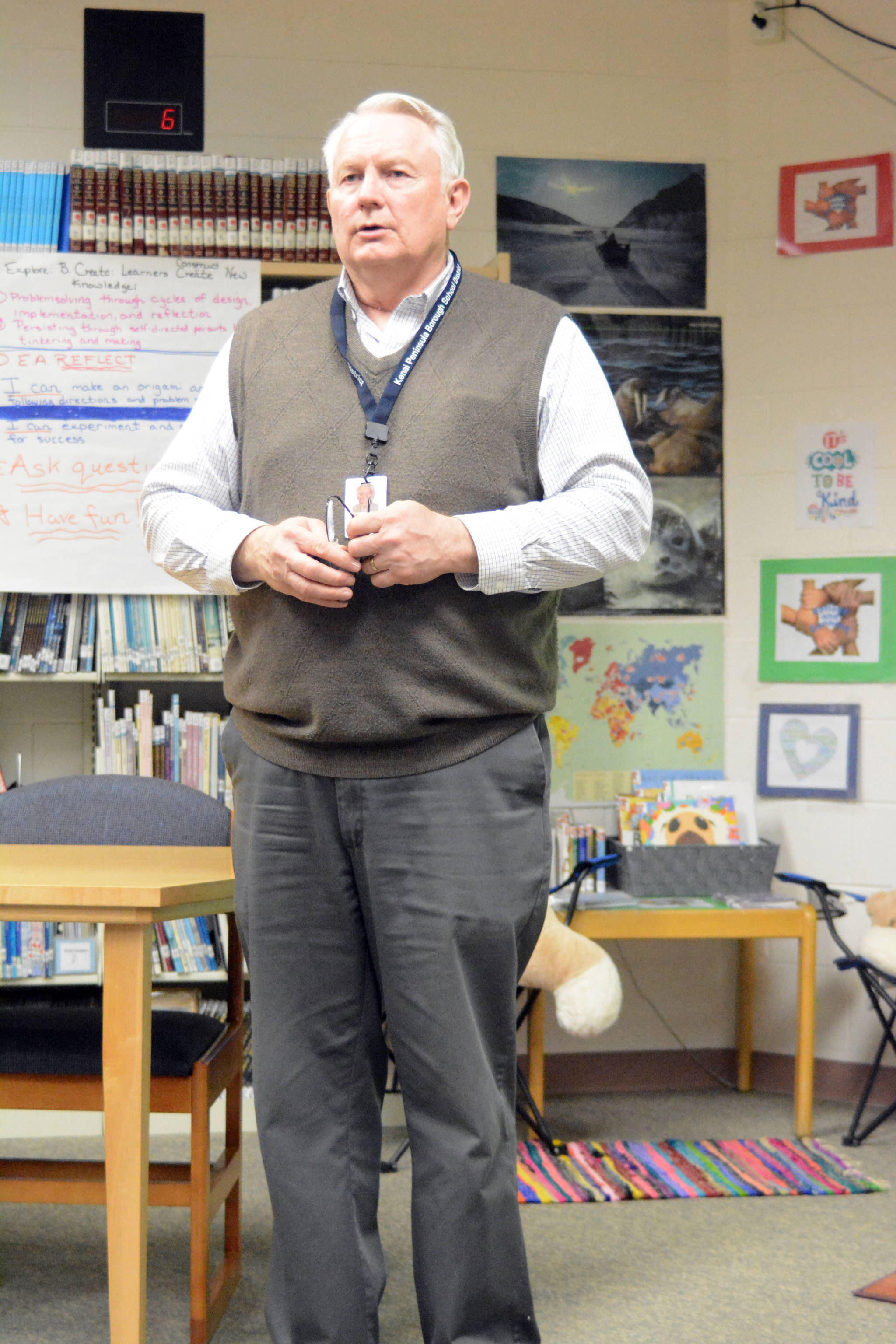Follow an Apple school bus as it does its bus route and you’ll note several things:
• This isn’t the Indianapolis 500 as buses cruise slowly — but safely — on the route, and
• Not a lot of children ride the bus. While drivers diligently stop at every scheduled route, at some routes no one boards, and for stops where students get on, it might only be one or two.
At an informational meeting on Jan. 25 at West Homer Elementary School with Kenai Peninsula Borough School District officials, parents, teachers and principals, the problem of ridership loomed large in the discussion. With the new single-tier bus system on the lower Kenai Peninsula and new school start and stop times, new bus stops, and sometimes longer routes, fewer children ride buses and more parents drive children to schools. In a bit of transportation ecology, where in nature one change has multiple, sometimes hidden effects, the bus changes have resulted in congestion at schools as parents drop off and pick up children. The earlier start and stop times for elementary students also have created challenges for working parents trying to get after-school day care.
School Board Member Zen Kelly alluded to that problem.
“One of the Catch 22s in all of this is we need several things to happen,” he said. “We need more kids riding the buses and also need successful after-school programs.”
If the buses are more efficient, more kids will ride, Kelly said.
Kelly and Homer’s other school board member, Mike Illg, attended last Thursday’s meeting.
With more parents driving kids to school, that has led to congestion at Homer’s two elementary schools, Paul Banks Elementary with grades pre-K-2 and West Homer Elementary with grades 3-6. West Homer also houses Big Fireweed Academy, the charter school program for grades 3-6. Fireweed students in grades K-2 go to Little Fireweed on East End Road. A traffic jam builds up at Paul Banks as drivers try to take a left turn onto East End Road near East Hill Road. Traffic also builds up at West Homer entering and exiting the school to get to Soundview Avenue and onto the Sterling Highway. One proposal is to build special bus lanes at West Homer, a capital investment that takes money and construction time — not an immediate solution.
Some parents suggested a fix to the Paul Banks congestion problem: operate school buses like city buses, for example picking up students at Paul Banks and dropping them off at West Homer where parents collect younger children with their older siblings. Maybe a Paul Banks bus could drop off a student at an after-school program at West Homer, Illg suggested.
“There’s no better safe place than a school,” he said.
District policy doesn’t allow that, though, said David May, director of operations and planning for the district. Buses can only pick up students at schools in the afternoon, not drop them off. On the tight schedules buses run, minutes spent dropping off kids at schools would mean delays down the line. There’s also the issue of student safety. If a child gets dropped off not at a bus stop, someone has to take responsibility for that student.
“Every time we make it more complex, we increase the possibility we will screw up,” May said.
Kelly also suggested another idea, alternate hubs where students can be dropped off, like the Kachemak Community Center in Kachemak City.
“The key is someone is there to pick up kids,” May said. For preschoolers and kindergarteners a parent has to meet the student, he said.
The Kachemak Bay Coalition, a group of parents, school officials and nonprofits, has been working together to increase after-school programs. The district can help with that, Kelly said.
“We’re willing to work with anybody, but we need everybody,” he said.
“The district can help, but we’re not driving that bus,” May added.
Pun aside, May also meant that literally. Children on a bus route can be dropped off at licensed day-care facilities where an adult takes responsibility for picking up a child, but not at programs like swim club at the Kate Kuhns Aquatic Center at Homer High School. Illg said one solution might be to charter a school bus for after-school program drop-offs, but that would cost $38,000 a year. He is exploring grants to pay for that.
On the upper peninsula, one program that can accept dropped-off students is the Boys &Girls Club. Clubs have memorandum of agreements to be a safe haven for students. A club representative meets students and takes responsibility, May said. The district is exploring reviving Boys &Girls Clubs in Homer, probably at school sites.
One parent at the meeting raised the idea of going back to a two-tier system, with more buses running routes so schools can start and end at the same time. Other than parents having to adjust schedules when they have students going to school at different times, if middle or high school students get out at the same time as elementary schools, older children can provide day care for their younger siblings. District Superintendent Sean Dusek reminded the meeting of the calculus behind more economical routes: in times of tight budgets, the money saved means teacher positions won’t be cut.
Dusek said he was glad to see parents and district officials weren’t casting blame at each other and trying to listen.
“We want this to work. We want people to be as satisfied as much as possible with the services,” he said.
As a priority, Dusek said he wants to address the congestion problem.
Above all, the students are the priority, May said
“This is our future, our next generation,” he said. “This is why we’re here.”
Reach Michael Armstrong at michael.armstrong@homernews.com.


